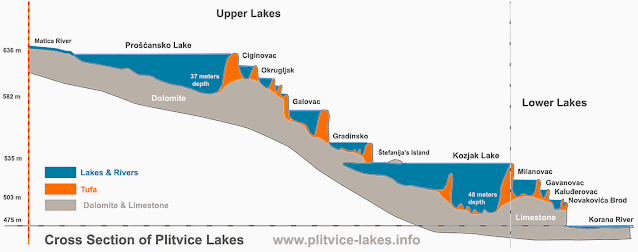 |
| Plitvice Lakes: Tufa or Meteogene Travertine or Sedra (Croatian term): It is a porous variety of limestone deposits formed on waterbeds when calcium-rich water bodies create carbonates which form sticky layers on moss and algae present in the water. Over the years, these deposits form tower-like formations |
 |
| Thermogene Travertine in Yellow Stone National Park |
Meteogene travertine (Tufa) vs Thermogene travertine
The main difference between meteogene travertine and thermogene travertine is that one is formed in unheated conditions and one is formed in a heated condition. Meteogene travertine is highly porous and spongy and is formed in cooler temperatures while thermogene travertine is less in porosity and needs very high temperatures for its formation. Meteogene travertine is a result of atmospheric and epigeal activities while thermogene travertine is a result of volcanic activities.
 |
| Source of image: Link The Plitvice region receives abundant rain feeding a continuous supply of water to the lakes and rivers which are rich in moss and algae which in turn supply carbon dioxide. The rich forest cover provides an abundance of oxygen which helps sustain life forms in the region. The Dolomite and Limestone rich soil supplies a high volume of calcium-rich ions. |
Process of Tufa creation
Ca++ (calcium ions in calcium rich water and soil) + H2O (water) = Ca(OH)2 (Calcium hydroxide)
Ca(OH)2 +CO2 (carbon dioxide from atmosphere and the aquatic life) = CaCO3 (calcium carbonate limestone / tufa) +H2O
In simple words, quicklime when mixed with water forms calcium hydroxide. This in turn converts to calcium carbonate when Carbon dioxide released by the aquatic organisms reacts with calcium hydroxide. The carbon dioxide released by the underwater organisms gets released to the surface in the colder seasons. The calcium carbonate deposits which are insoluble in water then start depositing on the moss and algae on the water surface eventually forming porous, spongy tufa.
Tufa towers eventually form small tower-like structures creating barriers in the flowing water thus forming a series of lakes and waterfalls.
 |
| Karst in South Thailand |
A landscape rich in tufa is called Karst. The main features of Karst topography are the abundance of soluble calcium in the form of limestone, dolomites, gypsum, etc, clean water full of aquatic organisms and lifeforms, and a landscape with sink holes, fissures, underground streams, and caves.
 |
| Picture source: Link |

No comments:
Post a Comment
Please Share Your Thoughts :)